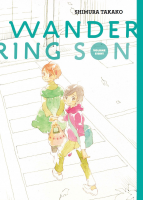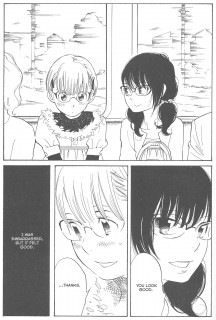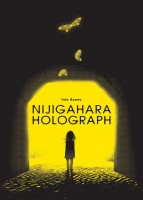 Creator: Takako Shimura
Creator: Takako Shimura
U.S. publisher: Fantagraphics Books
ISBN: 9781606998311
Released: May 2015
Original release: 2008
Wandering Son by Takako Shimura is a manga series that is incredibly important to me on a very personal level. The series’ exploration of personal identity, especially in regards to gender and sexual identity, is beautifully done with great sensitivity. It’s a rare comic in which gender expression and other issues relating to gender are treated realistically and not as a joke. Wandering Son is an authentically meaningful series. Fantagraphics Books has been releasing the manga in English in a lovely hardcover edition; I only wish that the individual volumes were able to be released more frequently. Wandering Son, Volume 8 was first published in Japan in 2008 while the English translation was published in 2015. Wandering Son concluded in 2013 with its fifteenth volume, meaning that the eighth volume marks the beginning of the second half of the series. I am so incredibly grateful that Wandering Son is being translated and look forward to reading the remaining volumes.
Spring has come, which means a new school year is about to begin. Shuichi, Takatsuki, and their classmates are entering the eighth grade, but with a new year comes new class assignments. The students, whose often precarious friendships and relationships were at least temporarily stable, once more find themselves confronted with new and changing group dynamics. Some friends are separated while others are reunited. And of course, not-quite-friends and past bullies are included in the mix as well, creating some challenging and awkward situations for everyone involved. Springtime has come for some of the young people in a more figurative sort of way as well. Anna and Shuichi continue to date each other and enjoy being together despite Shuichi’s lingering affections for Takatsuki. Everyone has mostly come to terms with this development in their relationship, but more than one person has commented that Takatsuki and Shuichi would make an ideal couple.
 I’ve come to really like Anna as a character. When she was first introduced in the series, she came across as aloof and perhaps even a bit mean-spirited, but as Wandering Son has progressed, more about Anna has been revealed. It’s not exactly that she’s bad-natured, she just doesn’t have a high tolerance for people who don’t approach their lives and work seriously. Anna can be surprisingly mature for her age—something that may probably be true for many of the younger characters in Wandering Son—but I still find her personality and character to be a believable. She is extraordinarily accepting and kind in her own fashion, seeming to lack the jealous tendencies that cause so many problems for her peers. But what I love most about Anna in Wandering Son, Volume 8 is her acceptance and support of Shuichi through their relationship as a couple. She is perfectly content to go on dates as two girls if that’s what Shuichi wants and she never denigrates Shuichi’s interests or feelings.
I’ve come to really like Anna as a character. When she was first introduced in the series, she came across as aloof and perhaps even a bit mean-spirited, but as Wandering Son has progressed, more about Anna has been revealed. It’s not exactly that she’s bad-natured, she just doesn’t have a high tolerance for people who don’t approach their lives and work seriously. Anna can be surprisingly mature for her age—something that may probably be true for many of the younger characters in Wandering Son—but I still find her personality and character to be a believable. She is extraordinarily accepting and kind in her own fashion, seeming to lack the jealous tendencies that cause so many problems for her peers. But what I love most about Anna in Wandering Son, Volume 8 is her acceptance and support of Shuichi through their relationship as a couple. She is perfectly content to go on dates as two girls if that’s what Shuichi wants and she never denigrates Shuichi’s interests or feelings.
For the most part, Wandering Son tends to be a fairly quiet series, which is not to say there isn’t drama. And I certainly don’t intend to downplay the very real and intense emotions experienced by the characters as they struggle through their adolescence and personal turmoils. Those are central to Wandering Son. However, the eighth volume is the first volume that really ends with a dramatic turn of events that could be described as a cliffhanger. Throughout Wandering Son, Shuichi and Takatsuki have become more comfortable and increasingly bolder with how they express themselves in the clothes they wear, largely because they’ve received encouragement from their classmates and friends. But up until this volume, that outward expression has mostly been limited to their private lives; now they’ve begun to push the boundaries in how they dress at school, which has an explicit dress codes and uniforms based on gender. I am very glad to see the two of them developing a firmer understanding and acceptance of who they are, but I also worry for them because, as Wandering Son honestly portrays, the world can sometime be a very cruel place.




